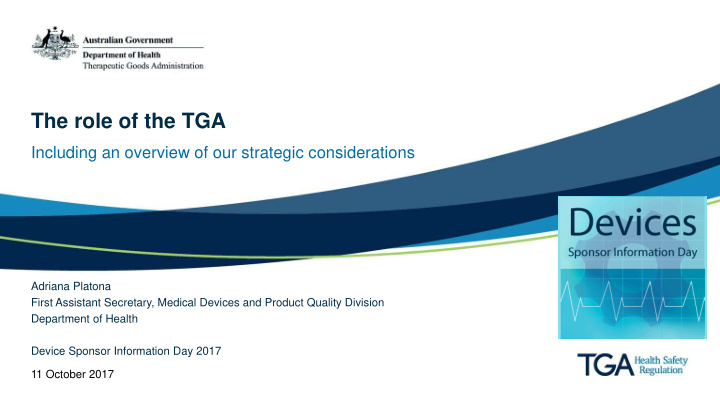



The role of the TGA Including an overview of our strategic considerations Adriana Platona First Assistant Secretary, Medical Devices and Product Quality Division Department of Health Device Sponsor Information Day 2017 11 October 2017
What I’ll cover today • Acknowledgements • Overview of TGA – Our mission • Risk-based approach to regulation • How we undertake our role • Strategic priorities • Guiding principles • Some statistics 1
Firstly, this day would not be possible without: 2
Overview of the TGA • We are part of the Australian Government Department of Health • Our decisions are based on the Therapeutic Goods Act 1989 • Main offices in Canberra – satellite offices in Sydney, Melbourne, Adelaide and Brisbane • Operations fully cost recovered from industry • Our mission: To safeguard and enhance the health of the Australian community through the effective and timely regulation of therapeutic goods 3
Overview of the TGA – What we do • Evaluate therapeutic goods before they are supplied • Focus on safety, quality and performance • Monitor products once they are on the market • Allow for access to unapproved goods in certain circumstances • We do not make decisions based on value for money or make decisions about which products receive Government subsidy 4
Risk-based approach to regulation • All therapeutic goods have some level of risk • Our role is to ensure that, on balance, the risks are acceptable when weighed against intended benefit • Our 'risk-based' approach to regulating therapeutic goods is designed to ensure that regulation is commensurate with the risks posed by particular therapeutic goods 5
We undertake our role by • Regulating manufacturers and sponsors of therapeutic goods • Undertaking pre-market assessments by applying scientific and clinical expertise • Assessing the quality and compliance of therapeutic goods on the market, including through laboratory testing where appropriate • Implementing a range of regulatory actions that are proportionate to the potential risk arising from the non-compliance or safety risk • Working collaboratively with consumers, health professionals, industry, technical and scientific specialists and our international regulatory counterparts 6
Strategic priorities As outlined in the Health Portfolio Budget Statements, our priorities for 2016-2017 are: 1. Regulating therapeutic goods for safety, effectiveness / performance and quality 2. Participating in international regulatory convergence and work sharing activities 3. Promoting best practice regulation 7
Guiding principles Regulator Performance Framework - KPIs 1. Regulators do not unnecessarily impede the efficient operation of regulated entities. 2. Communication with regulated entities is clear, targeted and effective. 3. Actions undertaken by regulators are proportionate to the regulatory risk being managed. 4. Compliance and monitoring approaches are streamlined and coordinated. 5. Regulators are open and transparent in their dealings with regulated entities. 6. Regulators actively contribute to the continuous improvement of regulatory frameworks. 8
Some statistics for the Medical Devices Branch (2016-17) • We received – Applications: 5,524 – Device Incident Reports: 4,896 • We completed – Applications: 5,806 – Device Incident Reports: 4,918 – Compliance / post-market reviews: 328 • We conducted – 64 manufacturer audits (26 of these overseas) 9
But how did we perform? Applications for ARTG inclusion • – Completed without audit: 2,105 MD (not IVDs) and 77 IVDs – Non-compulsory audits: • MD (not IVDs) – 310 • IVDs - 10 – Compulsory audits • MD (not-IVD) Level 1 – 40 • MD (not-IVD) Level 2 – 471 • IVD – 82 10
But how did we perform? • Conformity assessment applications – Required to complete within 255 working days – 100% were completed within 200 working days • Medical device incident reports – Target 90 working days - 95% were completed within timeframe. 11
Questions? 12
Recommend
More recommend